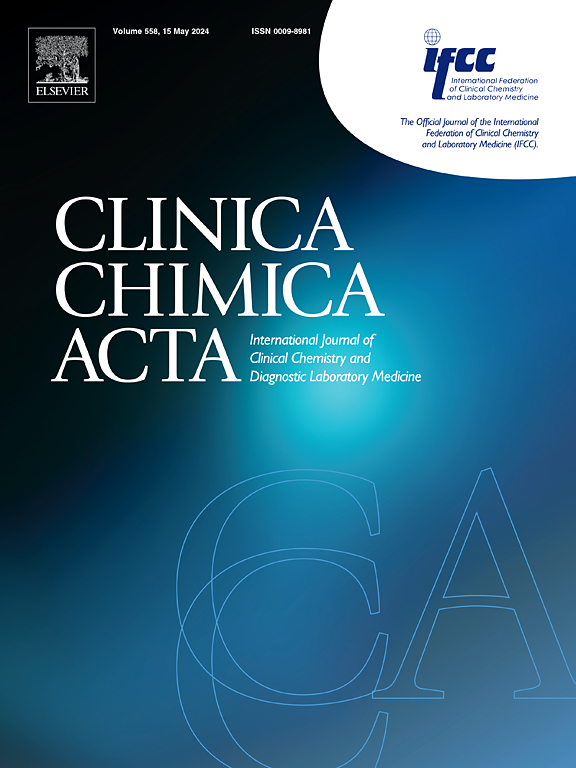Macrocomplexes: An establishing critical limits of post-PEG serum enzymes and proteins in adults and children
IF 3.2
3区 医学
Q2 MEDICAL LABORATORY TECHNOLOGY
引用次数: 0
Abstract
Background
Exclusion of serum macroform presence is essential to avoid potential misdiagnosis. The aim of this study was to determine critical limits (CL) for enzymes (total and pancreatic amylase, AMY and pAMY; aminotransferases, AST and ALT; alkaline phosphatase, ALP; creatine kinase, CK; lipase, LIP; gamma-glutamyl transferase, GGT; lactate dehydrogenase, LDH) after polyethylene glycol (PEG) precipitation in children and adults.
Methods
A total of 126 sera of patients suspected for macroenzyme presence (adults or children) was matched by serum enzyme activity of controls and all these sera were precipitated by PEG. PEG-precipitable activity ( %PPA) and CLs of %PPA were calculated for adults, children, and controls.
Results
CLs of %PPA were substantially lower than common 60 % for ALP and CK in all subjects. Significant differences between adults and children were found for ALT and ALP (lower in children), and LIP and CK (higher in children). No meaningful correlation was found between initial enzyme activity and %PPA.
Conclusions
Age specific CLs should be used for ALP, ALT, CK, and LIP. Generally accepted value of %PPA of 60 % may be used with caution for AMY, pAMY, AST, GGT, and LDH. A careful selection of CLs is needed for timely detection of macrocomplexes.
宏观复合物:建立成人和儿童peg后血清酶和蛋白质的临界界限
背景:排除血清巨形的存在是必要的,以避免潜在的误诊。本研究的目的是确定酶(总淀粉酶和胰淀粉酶,AMY和pAMY)的临界极限(CL);转氨酶、AST和ALT;碱性磷酸酶;肌酸激酶;脂肪酶,唇;-谷氨酰转移酶;乳酸脱氢酶(LDH)在聚乙二醇(PEG)沉淀后的儿童和成人。方法将126例疑似存在大酶的成人和儿童血清与对照组的血清酶活性进行比对,并采用聚乙二醇法沉淀。计算成人、儿童和对照组的peg可沉淀活性(%PPA)和%PPA的CLs。结果PPA的cls值明显低于ALP和CK的60%。ALT和ALP(儿童较低)和LIP和CK(儿童较高)在成人和儿童之间存在显著差异。初始酶活性与%PPA之间无显著相关性。结论ALP、ALT、CK、LIP均应采用sage特异性CLs。对于AMY、pAMY、AST、GGT和LDH,一般接受60%的%PPA值谨慎使用。为了及时检测大型复合物,需要仔细选择CLs。
本文章由计算机程序翻译,如有差异,请以英文原文为准。
求助全文
约1分钟内获得全文
求助全文
来源期刊

Clinica Chimica Acta
医学-医学实验技术
CiteScore
10.10
自引率
2.00%
发文量
1268
审稿时长
23 days
期刊介绍:
The Official Journal of the International Federation of Clinical Chemistry and Laboratory Medicine (IFCC)
Clinica Chimica Acta is a high-quality journal which publishes original Research Communications in the field of clinical chemistry and laboratory medicine, defined as the diagnostic application of chemistry, biochemistry, immunochemistry, biochemical aspects of hematology, toxicology, and molecular biology to the study of human disease in body fluids and cells.
The objective of the journal is to publish novel information leading to a better understanding of biological mechanisms of human diseases, their prevention, diagnosis, and patient management. Reports of an applied clinical character are also welcome. Papers concerned with normal metabolic processes or with constituents of normal cells or body fluids, such as reports of experimental or clinical studies in animals, are only considered when they are clearly and directly relevant to human disease. Evaluation of commercial products have a low priority for publication, unless they are novel or represent a technological breakthrough. Studies dealing with effects of drugs and natural products and studies dealing with the redox status in various diseases are not within the journal''s scope. Development and evaluation of novel analytical methodologies where applicable to diagnostic clinical chemistry and laboratory medicine, including point-of-care testing, and topics on laboratory management and informatics will also be considered. Studies focused on emerging diagnostic technologies and (big) data analysis procedures including digitalization, mobile Health, and artificial Intelligence applied to Laboratory Medicine are also of interest.
 求助内容:
求助内容: 应助结果提醒方式:
应助结果提醒方式:


